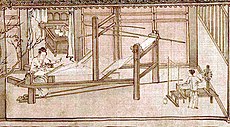Natural Protein Fiber Silk
Silk
Silk is a very special natural protein fiber. It is lustrous, and smooth, drapes well and is very strong. Silk takes dyes very well and can be made in brilliant colors. Silk is important historically and has been in use for at least 5,500 years.
Most commercial silk is mulberry silk, which is also known as cultivated silk or bombyx silk. Mulberry silk is white, 10 to 14 microns in diameter and round in cross-section. This type of silk is produced from cocoons of the mulberry silkworm (Bombyx mori), a caterpillar that eats mulberry leaves.
 |
| Silk Cocoons |
 |
| Silk fiber |
China
The Emperors of China strove to keep knowledge of sericulture secret to maintain the Chinese monopoly. Nonetheless sericulture reached Korea with technological aid from China around 200 BC the ancient Kingdom of Khotan by AD 50, and India by AD 140.
In the ancient era, silk from China was the most lucrative and sought-after luxury item traded across the Eurasian continent, and many civilizations, such as the ancient Persians, benefited economically from trade.
- Chinese silk making process










Silk Fabric
The rich history of silk only adds to its appeal. Legend has it that chief wife of Emperor Huang Ti (2677-2597 B.C.) discovered silk when a cocoon dropped from a tree to her cup of tea, and Lady His-Ling drew out a long thread. The Chinese maintained a monopoly on silk production for thousands of years, exporting to the Middle East and Europe via the legendary Silk Road. It wasn’t until the time of the Crusades that Italy became known for its sericulture with France following closely behind. Some favorite high quality silk fabric include silk charmeuse, silk chiffon, silk crepe, silk organza, and silk satin.

Silkworms Eating, Cuddling & Spinning Time-lapse







No comments